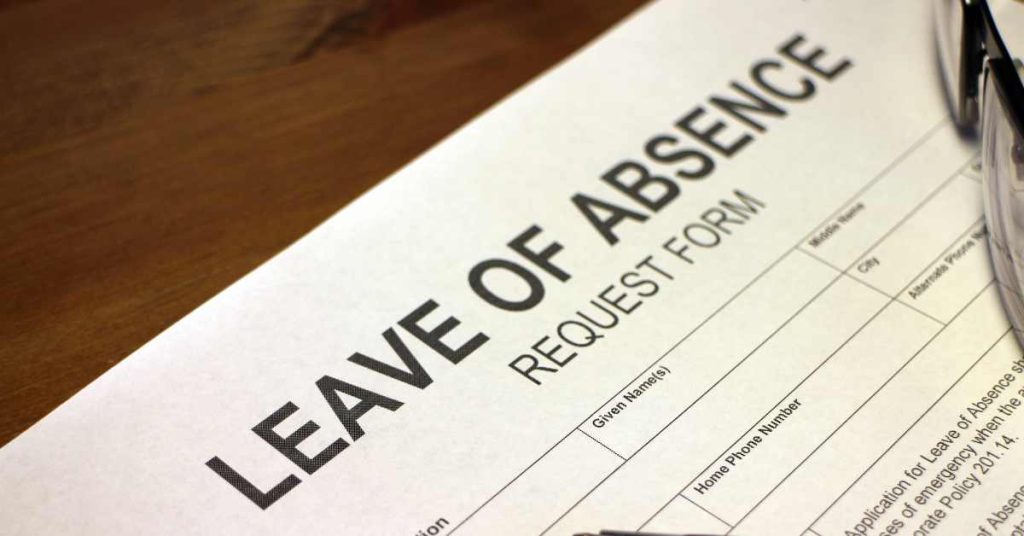In today’s dynamic workforce, understanding employee rights and benefits is essential for both employers and workers. One topic that often raises questions is the leave of absence, what it entails, who qualifies, whether it’s paid, and how long it can last. Whether you’re wondering “what is leave of absence?” or trying to navigate the process of requesting one, this article will define the concept, outline types of leaves, and explore whether leaves are paid or unpaid.
Leave of Absence Meaning
A leave of absence (LOA) refers to a period of time an employee takes off from work while retaining their job status. It can be categorized as either mandatory (e.g., protected under laws like the Family and Medical Leave Act) or voluntary (granted by employer discretion). LOAs can be taken for health-related issues, family emergencies, personal development, or military service.
What Does Leave of Absence Mean?
In simple terms, it means an employee is temporarily excused from work duties with the intent to return once the situation prompting the leave is resolved. This time off may be paid or unpaid, depending on the type and legal framework governing it.
Types of Leave of Absence in the U.S.
1. Family and Medical Leave Act (FMLA) – Unpaid
Under federal law, the FMLA allows eligible employees up to 12 weeks of unpaid, job-protected leave in a 12-month period for:
- Birth or adoption of a child
- Caring for a family member with a serious health condition
- The employee’s own serious health condition
- Military caregiver leave (up to 26 weeks)
Eligibility requires that the employee has worked for their employer for at least 12 months and clocked in 1,250 hours in the past year. The employer must have 50+ employees.
2. Medical Leave of Absence
This may overlap with FMLA, but can also be governed by state laws or employer policies. A medical leave of absence is used for recovering from surgery, illness, or injury. It can be paid through short-term disability insurance in states like California, New Jersey, and New York.
Mental health leave of absence paid: Though not explicitly named in federal law, mental health conditions may qualify under FMLA or ADA. Some employers also offer specific programs to address burnout or stress, particularly in high-pressure roles.
3. Pregnancy Disability Leave (PDL) – Paid or Unpaid
In states like California, PDL is offered in addition to FMLA. It covers leave needed for pregnancy-related medical conditions, before or after childbirth. This leave may be paid or unpaid depending on state law or employer policy.
4. Paid Sick Leave – State-Specific
While there’s no federal mandate, many states (CA, NY, WA, NJ, MA) require employers to provide paid sick leave. It typically covers:
- Minor illnesses
- Doctor appointments
- Caring for sick family members
5. Military Leave – Unpaid with Job Protection
Under USERRA, employees who serve in the armed forces, National Guard, or Reserves are entitled to unpaid leave with job protection and benefits continuation.
6. Disability Leave – Usually Unpaid Unless Covered
Under the Americans with Disabilities Act (ADA), employers may be required to provide leave as a reasonable accommodation. Some states offer short-term disability insurance that can partially pay wages during this leave.
7. Personal Leave of Absence
This is a voluntary leave granted at the employer’s discretion for reasons like:
- Travel or education
- Mental health breaks
- Family obligations not covered by FMLA
Typically, personal leaves are unpaid and not protected by law, though some companies may allow extended unpaid leave with a guarantee of reemployment.
8. Workers’ Compensation Leave – Paid
If an employee is injured or becomes ill due to work, workers’ comp laws in each state require employers to provide paid leave, covering medical expenses and a portion of lost wages.
9. Jury Duty, Voting, and Bereavement Leave
- Jury Duty: Paid or unpaid depending on state law. Employers cannot penalize employees for jury service.
- Voting Leave: Some states mandate paid time off to vote if workers don’t have time before or after shifts.
- Bereavement Leave: Not required federally. Some states (e.g., Oregon) offer unpaid leave. Typical employer policy grants 3–5 days.
Common Questions About Leave of Absence
Is a Leave of Absence Paid?
It depends. FMLA, military, and personal leaves are typically unpaid, while sick, disability, or workers’ compensation leave can be paid through insurance or state-mandated programs.
Do You Get Paid for Leave of Absence?
You may get paid if your leave qualifies under:
- Paid sick leave laws
- State disability insurance
- Workers’ compensation
- Company policy
Otherwise, leaves like FMLA or personal time are generally unpaid.
How Long Is a Leave of Absence?
- FMLA: Up to 12 weeks (26 for military caregiver)
- Pregnancy disability: Up to 4 months in some states
- State disability: Usually 6 to 12 weeks
- Personal leave: Varies by employer (weeks to months)
How to Take a Leave of Absence from Work
- Understand your rights – Research federal, state, and employer-specific policies.
- Consult HR or your supervisor – Clarify requirements, documentation, and leave duration.
- Submit a formal request – In writing, specify start date, return date, and reason.
- Provide documentation – Especially for medical, disability, or family leave.
- Stay in communication – Keep your employer informed during your leave.
How Do I Take a Leave of Absence from Work?
Follow your company’s policy and gather documentation. If your leave falls under FMLA or ADA, your employer is legally required to respond within a specified timeframe (often five business days).

Employer Considerations for Managing Leave of Absence
Employers must comply with federal and state laws to avoid legal risk. Key considerations include:
- Documentation: Maintain clear records of requests, approvals, and medical certifications.
- Non-discrimination: Leave policies must apply equally to all eligible employees.
- Coordination with benefits: Ensure continuation of health insurance during protected leaves.
- Job protection: For FMLA, USERRA, and ADA-related leaves, reinstatement is mandatory.
What Is Intermittent Leave of Absence?
An intermittent leave of absence allows an employee to take leave in separate blocks of time—rather than one continuous period—for a single qualifying reason. This type of leave is most commonly associated with the Family and Medical Leave Act (FMLA), but it may also be granted under other medical or personal circumstances depending on employer policy.
Intermittent Leave of Absence Meaning
The leave of absence meaning changes slightly with intermittent leave: instead of weeks or months off, employees may take hours or days off sporadically over a longer timeframe. For example, an employee undergoing regular medical treatment or managing a chronic condition might need time off every other week or a few hours per day.
When Can You Take Intermittent Leave?
Under FMLA, intermittent leave is permitted when medically necessary for:
- Treatment of a serious health condition
- Recovery periods following treatment
- Caring for a family member with a serious health issue
- Pregnancy-related needs, such as prenatal appointments or morning sickness
Employers may also allow intermittent leave for birth, adoption, or foster care placement, but approval is discretionary if the leave isn’t medically required.
Is Intermittent Leave Paid?
Intermittent leave is typically unpaid, just like standard FMLA leave. However, employees may choose (or be required) to use accrued paid leave—such as sick time or vacation—during these intermittent absences, depending on company policy.
This means that while intermittent leave is generally unpaid, it can be partially paid if other forms of paid time off are available.
How to Request Intermittent Leave of Absence
If you’re wondering how do I take a leave of absence from work on an intermittent basis, here are the steps:
- Provide advanced notice when foreseeable (at least 30 days before treatment, if possible).
- Submit medical certification confirming the need for intermittent leave.
- Work with HR to develop a leave schedule that meets both medical and business needs.
- Track your time accurately to stay within the 12-week FMLA limit (measured in hours/days used).
Employers can require that the employee attempt to schedule leave to minimize workplace disruption, especially in roles critical to operations.
Employer Considerations for Intermittent Leave
- Job protection applies the same as for standard FMLA leave.
- Employers may temporarily transfer employees to an alternative role that better accommodates the intermittent schedule—if it provides equivalent pay and benefits.
- Employers cannot deny intermittent FMLA leave if it meets the eligibility requirements and medical need is documented.
Final Thoughts
Understanding what is a leave of absence is essential in today’s workforce. Whether you’re an employer creating compliant policies or an employee exploring your options, knowing your rights and responsibilities ensures a smooth process. While some leaves like medical leave of absence or mental health leave of absence paid are protected or paid under certain laws, others depend on your company’s internal policies.
If you’re asking, “Is leave of absence paid?” or “How do I take a leave of absence from work?”, the answer often lies in the intersection of federal laws, state regulations, and company culture. With the right approach, a leave of absence can support work-life balance while safeguarding job security.


